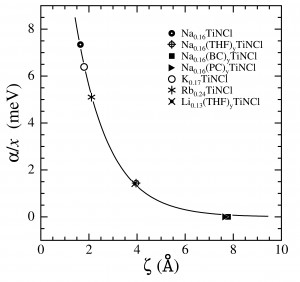Comment on “Superconductivity in electron-doped layered TiNCl with variable interlayer coupling”, D. R. Harshman and A. T. Fiory [arXiv]
In their article, Zhang et al. [Phys. Rev. B 86, 024516 (2012)] present a remarkable result for Ax(S)yTiNCl compounds (α-phase TiNCl partially intercalated with alkali A and optionally co-intercalated molecular species S), finding the superconducting transition temperature TC scales with d–1, where the spacing d between TiNCl layered structures depends on intercalant thickness. Recognizing that this behavior indicates interlayer coupling, Zhang et al. cite, among other works, the interlayer Coulombic pairing mechanism picture [Harshman et al., J. Phys.: Condens. Matter. 23, 295701 (2011)]. This Comment shows that superconductivity occurs by interactions between the chlorine layers of the TiNCl structure and layers containing Ax, wherein the transverse Ax-Cl separation distance ζ is smaller than d. In the absence of pair-breaking interactions, the optimal transition temperature is modeled by TC0 ∝ (σ/A)1/2 ζ–1, where σ/A is the fractional charge per area per formula unit. Particularly noteworthy are the rather marginally-metallic trends in resistivities of Ax(S)yTiNCl, indicating high scattering rates, which are expected to partially originate from remote Coulomb scattering (RCS) from the Ax ions. By modeling a small fraction of the RCS as inducing pair-breaking, taken to cut off exponentially with ζ, observations of TC < TC0 are quantitatively described for compounds with ζ < 4 Å, and TC ≈ TC0 for Na0.16(S)yTiNCl with propylene carbonate and butylene carbonate co-intercalants for which ζ > 7 Å. Since a spatially separated alkali-ion layer is not formed in Li0.13TiNCl, the observed TC of 5.9 K is attributed to an intergrowth phase related to TiN (TC = 5.6 K).
D. R. Harshman and A. T. Fiory, Phys. Rev. B 90, 186501 (2014).












